Route through the charming villages of Navarra
Historic medieval villages, spectacular Pyrenean villages, essence of Navarre
Historic medieval villages, spectacular Pyrenean villages, essence of Navarre

Walking through the streets of the towns and cities of Navarre is an authentic experience that will immerse us in its history and culture, will cradle us with the wonderful landscapes that surround them and will allow us to get to know every beautiful corner of this historic land. Careful medieval villages that still preserve the lordship of past times, typical Pyrenean villages whose beautiful picture seems to have been taken from a postcard, towns that in any case invite us to get to know them and visit them calmly, to let ourselves be surprised by their charms and to enjoy and discover their traditions and the customs of their people.
There is no doubt that we would never tire of including Navarrese towns in this Route through the charming villages of Navarre, a fact that makes it even more difficult to choose which one has to form an unavoidable part of the itinerary that any person has to take into account when planning their trip or escape to this land. Castles and fortresses, sanctuaries and imposing temples, regal mountains populated by thick forests that look like authentic jungles, in short an endless number of attractive and tempting motives will accompany us along our route through Navarre. An itinerary that is quite a journey in time that, for example, will put us for an instant in the skin of pilgrims to visit some of the villages through which passes the Way of Saint James in the three routes that cross Navarre, the French Way, the Baztan Way and the Aragonese version of the French Way through Aragon, the Aragonese Way. All of them incredible places that will become part of our most precious memories.

The Ribera Navarra, to the south, has seen how Celts, Romans, Visigoths or Muslims have left their mark on it, without forgetting the interesting history that accompanies it after its reconquest. Tudela, the starting point for this route through the charming villages of Navarre, could not be an exception. The Monreal Tower, the Admiral's House or the Cathedral of Santa María de Tudela are just some of the examples of the rich artistic and historical heritage that await the visitor in Tudela. An experience that will be accompanied by the spectacular gastronomy that characterises and is the hallmark of this region of Navarre. Products of the Ribera Navarra, such as its vegetables, whose quality is internationally recognized and valued rivaling the monuments offered by the city to the visitor, as tasty and typical dishes or pinchos that we can taste in Tudela. But if we still have some time, the south of Navarre tempts us with other towns such as Cortes and its well-kept castle, or Fitero and its Monastery of Santa María.
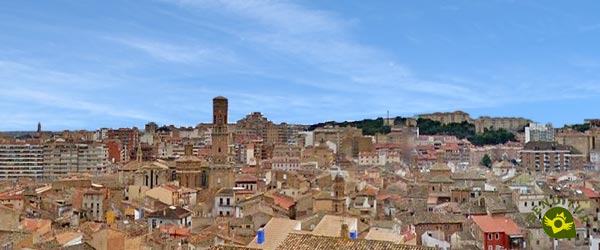

We continue our route through Navarre heading towards our next stop, following the road that connects Tudela with the capital, Pamplona, not without being tempted to detour for an instant to visit the restored castle of Marcilla, before submerging in the monumental Olite. There are not a few famous people who have formed and form part of its history, although there is no doubt that its monuments attract our attention as we enter its streets. The Old Palace or the Palace of the Theobalds, the Church of Santa María La Real together with the impressive Palace of the Kings of Navarre capture the glances of those who visit this locality of Navarre. A monumental heritage that is a true open book where we can immerse ourselves in the fascinating history of Olite as we stroll through, for example, the Palace of the Kings of Navarre, its rooms, its towers or its gardens, surrounded by the spectacular nature of what was once considered one of the most beautiful palaces in Europe.
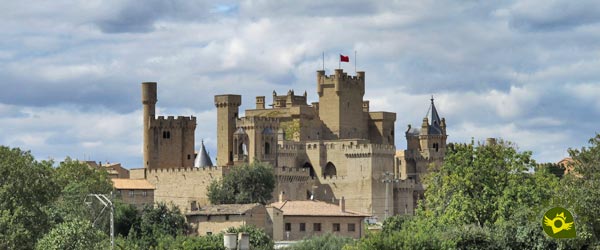

With the magical and unmistakable silhouette of the Palace of the Kings of Navarre behind us, we head towards our next destination, another of Navarre's markedly medieval villages. An itinerary that, just before arriving, gives us the opportunity to get to know San Martín de Unx. The imposing figure of the Church-fortress of Santa María de Ujué, at the top of the promontory on which the locality of Ujué sits, welcomes us on our arrival in this town. Exercising of border between the Ribera Navarra that we have just left and the Navarrese Pyrenees which await us, Ujué has constituted an important defensive enclave throughout its history. This fact forged its rich monumental patrimony that, together with its cobbled streets and regal buildings constituted around the fortress, have arrived to our days in a perfect state of conservation, maintaining almost intact its marked medieval character and granting it the distinction of being part of the association of the most beautiful villages of Spain.
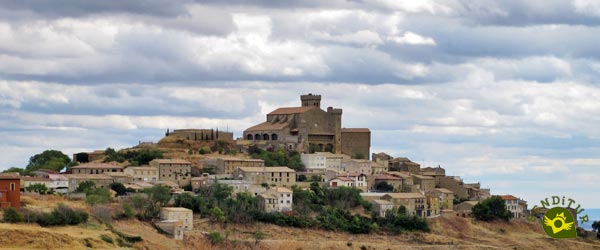

Once again, our next destination has an important history, as its monuments testify, as well as being an obligatory passage of the Way of Saint James, more specifically of the branch of the French Way through Aragon, once it has crossed Navarrese lands to unite with its other section. There are not a few palaces that Sangüesa treasures and that will surprise us as we walk through its streets after crossing the Aragon River and entering it. Some of them are royal buildings such as the Palace of the Kings of Navarre, also known as the Palace of the Prince of Viana, the Palace of the Marquises of Valle-Santoro or the House of the Sebastians. But without a doubt it is the Romanesque church of Santa María la Real and more specifically its impressive portico, with the 84 figures that make up the stepped archivolts that make them up, together with the rest of the arches and richly ornamented columns, the monument that takes the most photos and time of those who visit Sangüesa.


We say goodbye to Sangüesa to head towards the nearby Pyrenees motorway, which links Pamplona with Jaca, and following its route we will get closer to the easternmost valley of the Navarrese Pyrenees, the Roncal Valley, where we will see incredible landscapes and the villages in this valley. Burgui and its Museum of the Almadía, welcome us to this paradise of the nature of taken care of towns as the same Burgui or for example Roncal or Isaba. Locations taken care of to the detail that conserve with fidelity all their character, their traditions and customs. Villages that do not have large castles or palaces, but a great history behind them that combine perfectly with the wonderful natural environment that surrounds them, a temple for nature lovers and hiking trails or mountains. A history that goes back beyond the archaeological remains such as the Dolmen of Lubrakieta can be found and that along with the typical stately homes, monuments, churches and chapels are witnesses of the future of this land and its people. People who lived historical events such as the Battle of Olast, followed ancestral routes such as the Cañada Real de los Roncaleses and keep alive rites and pacts as old as the Tribute of the three cows.
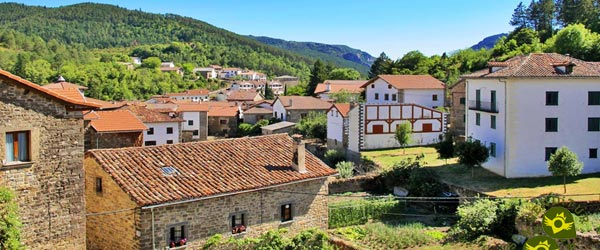

From Isaba we say goodbye to the Roncal Valley to jump the mountains that separate it from the Salazar Valley, crossing the foothills of the vigorous Irati Forest, which invites us to visit it to discover its hidden and beautiful corners while we walk along some of its paths. Ochagavía, in addition to surprising us with its typical houses with steep roofs, its medieval palaces such as Donamaría or its Church of San Juan Evangelista, without forgetting of course the Sanctuary of Our Lady of Muskilda, envelops us with its folklore, traditions and customs. The Dancers of Otsagabia, the myths and legends about the witches and sorcerers who lived here, their historical trials against these people accused of formulating spells and making covens, are part of this beautiful village in the Pyrenees of Navarre. A valley, the Salazar Valley, whose river sees how the different localities that make it up settle on its banks.
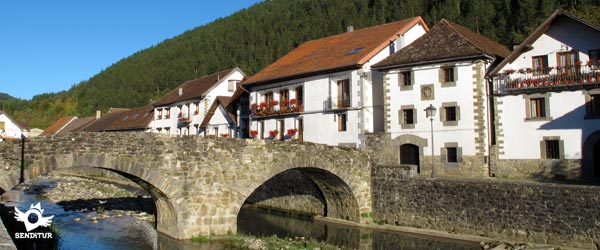

We say goodbye to the Salazar Valley, on our way through Ezcároz, to continue crossing this area of the Navarrese Pyrenees in search of our next stop, while we go through the different villages that leave the mountain road that guides us in this part of the Route through the charming villages of Navarre. The Way of Saint James awaits us and Roncesvalles, the starting point for many pilgrims on the French Way, is one of its symbols. Villages such as Burguete with its typical architecture force us to stop at them with pleasure. Worldwide known, among other things, for the wanderings and misadventures of Charlemagne and his precious Roland in the famous Battle of Roncesvalles. Here not only a very important part of Navarre's history awaits us, along with monuments such as the Church of the Royal Collegiate Church of Santa María or the Chapel of Sancti Spiritus, but also a natural environment of great beauty and incalculable value into which this small Navarrese town is integrated.
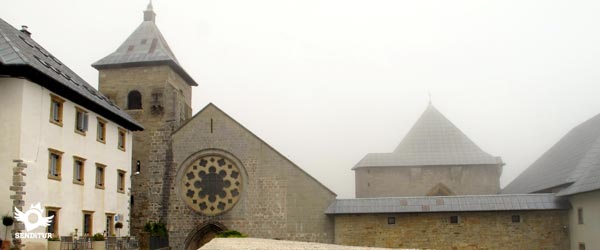

We take up our route again and following closely the French Way in its course towards Pamplona we will see ourselves travelling through villages such as Aurizberri-Espinal, Bizkarreta-Gerendiain, Lintzoain or Zubiri, where we will have to decide which path we will follow to reach the next destination of the trip. And we can do it from Pamplona itself, option with more distance but much better road or without moving away from the winding mountain roads that cross this area of the Pyrenees, then go to Eugi and the Forest of Quinto Real, and then walk to Irurita where we join the other option. Together we will reach Maya, and now we will come across the Baztán Way, another Way of Saint James for all those who travel through Navarre. This village combines almost like few others the nature that surrounds it with the history and the monuments that characterize it. The remains of its famous and heroic castle next to the marked physiognomy of its main street are a pleasure for the visitor.
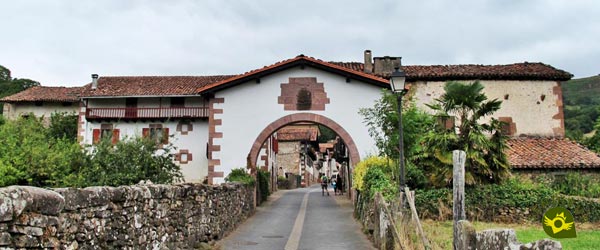

Again we go up the valley to go, without separating ourselves too much from the route of the Way of the Baztán, towards the next obligatory stop of this route for Navarre. We return to introduce ourselves, in a land of mysteries, legends and dark covens. But also in lands of beautiful landscapes and beautiful villages increased by the enigmatic mysticism that surrounds them. Cared for and pampered farmhouses share the limelight with the monastery of San Salvador and the Caves of Ikaburu or Urdax, real jewels of incalculable value that await us in this town in the north of Navarre. Interesting hiking routes, old paths, unite hidden corners and the different neighborhoods and villages of the area as with the nearby Zugarramurdi and its famous Cave of Zugarramurdi.
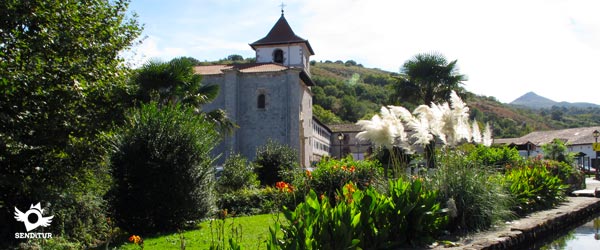

Once we have enjoyed this area of Navarre, we will jump into a new valley, the one that runs along the Bidasoa River. Through Dantxarinea we enter a few kilometres in France, approaching the tourist Sare and from there we will set course again to Navarre where Bera awaits us. To its intense cultural life, Bera adds its renowned gastronomy and monuments such as the Parish of San Esteban Protomártir, whose Romanesque organ is considered one of the best in Europe. From Bera, going up the course of the river Bidasoa, we will walk through villages and mountains towards the capital, towards Pamplona, and from there we will take up the steps of the French Way again and together we will approach the next stop on this route through the charming villages of Navarre.
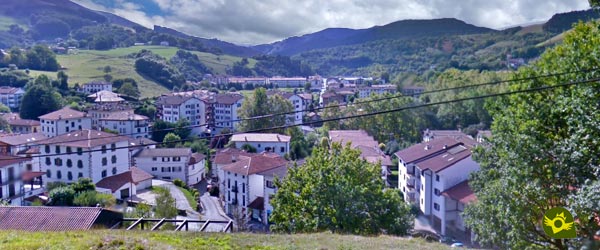

The figure of the Romanesque bridge through which pilgrims cross the River Arga as they pass through Puente la Reina is probably one of the symbols of this locality of Navarre, whose history has left an indelible mark on its streets and monuments, its squares and buildings, without the exuberant environment that had accompanied us until then. Historical religious and civil buildings such as the Church of the Crucifix, the Convent of the Commanders of the Sancti Spiritus of Zubiurrutia or the Casa del Vínculo make this historical mark evident, being points of obligatory visit in Puente la Reina-Gares, unbeatable point of union of the two slopes of the French Way, Navarre and Aragonese, better known as the Aragonese Way or the French Way through Aragon. Fact that also propitiated the settlement here of diverse religious orders and hospitals for pilgrims since as the saying says... And from here all the ways to Santiago become only one.


Our next stop will be another well-kept medieval town crowned by a true historical-artistic monument, The Cerco de Artajona, dating from the 12th century and which was in charge of the extreme defence of this noble town whose historic centre gives us a journey back in time. But Artajona also hides treasures lost in time such as its dolmens located in the fields and hills that surround the town, the dolmen of La Mina or the Portillo de Enériz are small jewels to be discovered by the visitor. While strolling through the streets of this medieval village is discovering corners such as the one surrounding the Church of San Saturnino among others. This fortress church is located inside the walled enclosure, a wall that conserves nine of the fourteen towers it consisted of and which is accessed through the gates of San Miguel and Remahua.


Another royal town awaits us and once again it does so hand in hand with the Way of Saint James, the axis of this area of Navarre and one of our route companions. The monumental city of Estella-Lizarra has a long and important history, as can be seen from the different monuments that await us there. The Church of San Pedro de la Rúa, the Holy Sepulchre, the Palace of the Kings of Navarre or the Palace of Justice, among other monuments, are undoubtedly unavoidable stops on any route through Estella. Architectural jewels that rival in prominence and beauty with the splendour of the nearby Urbasa-Andía Natural Park, a natural spot of incalculable value in which to enjoy the different hiking or mountain biking routes that run through it. But Estella-Lizarra also offers visitors its meticulous gastronomy and active cultural life, as attested to by the different events held throughout the year, such as the Medieval Studies Week or the Ancient Music Week.
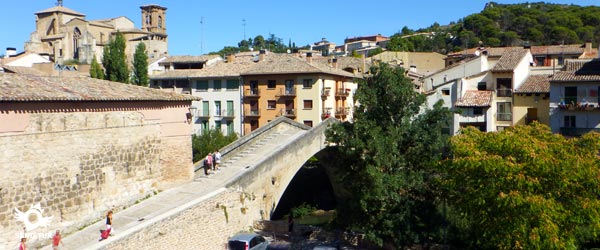

From Estella-Lizarra, following the course of the French Way, we set course for the last stop on this route through Navarre, but not before we are tempted to make a stop on the way in villages such as Villamayor de Monjardín, Los Arcos or Torres del Río among others, and where jewels await us such as the Church of the Holy Sepulchre. Viana is another of the towns in Navarre that surprises those who visit it. Its interesting cultural heritage is mixed with its customs and traditions, with its famous gastronomy and, of course, with the Jacobean character of this town. Its old quarter, surrounded by part of the old walls that protected it, houses monuments such as the Church of Santa María, the Convent of San Francisco or the Ruins of San Pedro, without forgetting its unique town hall whose Baroque style façade is worthy of admiration. But we can also enjoy festivals and cultural events such as the day of San Felices, or the foundation of Viana or the Viana City Crafts Fair, attractions that come to add to those that this charming town of Navarre already offers.
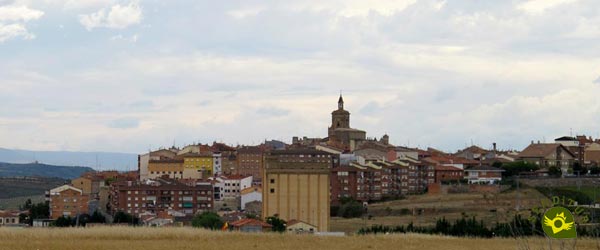
1-We are before a route of several days that we can structure by zones to be able to take advantage and to visit the different tourist and natural resources that we will find along the route.
2-Keep in mind that some stretches of road run through mountain areas, so they can be affected by the weather of the time of year in which you make the route, coming to find us closed or with many difficulties to move.
3-Do not forget to dedicate some time to enjoy the landscapes offered by the different natural sites that this route takes you, no doubt considerably broaden your experience in it.
4-The gastronomic offer of Navarre is very interesting, do not miss its dishes and the typical products of the land, of contrasted quality.
5-Keep in mind that some of the monuments and places that can be visited are subject to schedules, organize this section beforehand to avoid unnecessary travel and loss of time.
Map of the route
This map is a sketch made as an example of the route, in no case represents the best or the only itinerary to follow. Its development has not taken into account the current rules of circulation or the state of the places through which it passes and that could affect its layout.
¿Did you know that...
Pamplona also has an important historical and artistic heritage, worthy of a visit and a tour of its walls and bastions, discovering its unmistakable town hall and walking calmly through the typical streets of the famous running of the bulls of San Fermines.
Don't miss out...
The enclaves close to the towns you will visit on this route, such as the Castle of Javier or the Monastery of San Salvador de Leyre, both near Sangüesa, or the Royal Eugi Ammunition Factory near this town, or Santa María de Eunate a stone's throw from Puente la Reina.
![]()
Distance of the route
521 Km This figure may vary depending on the route we follow.
![]()
Duration of the tour
From 2 to 4 days
![]()
Time of year
All year round
![]()
Charm
Historical, cultural and landscape. This route shows us a large part of the territory of Navarre.
From the commitment of SENDITUR with Nature and the respect to the balance of the environment, SENDITUR urges you to travel in a responsible way, with low environmental impact and respecting at all times the Natural, Cultural and Social environment wherever you go.
Besides sharing with all of us your experience on the route we would be grateful if you could write to us to inform us of any erroneous or outdated information you may have found, or simply to let us know what you think at Thank you.
Route information updated on 21-05-2019. The route may vary greatly depending on the time of year, weather conditions and terrain, as well as the actions of third parties and the evolution suffered in the natural environment where it is located. All opinions, advice and/or assessments made by SENDITUR in their descriptions are for guidance only and are subject to and/or refer to the specific conditions of the specific day of the route, referring to that specific day, taken from trained people, with the appropriate experience and with a high level of physical and technical preparation as a reference, as well as correctly equipped.
All the times are approximate and take an orientative character, the stops have not been taken into account, no matter how small they are. All the information related to the route, texts, images, videos, maps, diagrams, tracks, towns, and places of tourist interest are published as a guide, and may not coincide with the current state of each place. Before undertaking any activity, assess your technical knowledge, your physical condition, find out about the weather and the variations that the route may undergo, equip yourself correctly, be prudent and responsible at all times, and do not exceed your capabilities. SENDITUR is not responsible for any misuse or inappropriate use of the comprehensive guides of its routes and/or publications as well as its electronic guides, nor for any variations in their descriptions for the aforementioned reasons, and recommends that everyone be responsible and prudent in carrying out the activity. We also encourage you to read books and specialised guides to complement the information described above.
Continue watching …